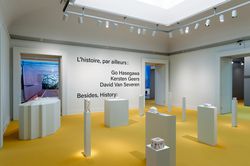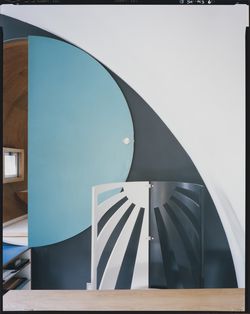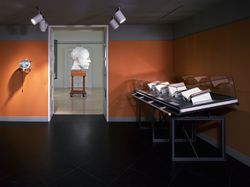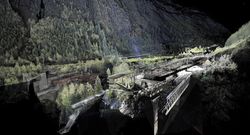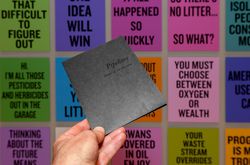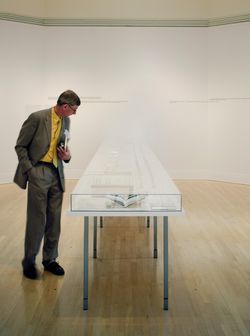Quel rôle l’histoire a-t-elle à jouer dans la pratique architecturale contemporaine? Plutôt que d’adopter une position postmoderne ou d’évoquer des débats anciens et des formes architecturales historiques, Go Hasegawa, Kersten Geers et David Van Severen abordent dans leur travail les problématiques actuelles dans un esprit de dialogue avec l’histoire. Même si les(...)
Salles principales Mot(s)-clé(s):
L’histoire, par ailleurs, Go Hasegawa, Kersten Geers, David Van Severen, Office, KGDVS, Bas Princen
10 mai 2017 au 15 octobre 2017
L’histoire, par ailleurs : Go Hasegawa, Kersten Geers, David Van Severen
Actions:
Description:
Quel rôle l’histoire a-t-elle à jouer dans la pratique architecturale contemporaine? Plutôt que d’adopter une position postmoderne ou d’évoquer des débats anciens et des formes architecturales historiques, Go Hasegawa, Kersten Geers et David Van Severen abordent dans leur travail les problématiques actuelles dans un esprit de dialogue avec l’histoire. Même si les(...)
Salles principales Mot(s)-clé(s):
L’histoire, par ailleurs, Go Hasegawa, Kersten Geers, David Van Severen, Office, KGDVS, Bas Princen
Figure ayant profondément marqué l’architecture d’après-guerre au Japon, Kazuo Shinohara s’est surtout fait connaître pour ses maisons individuelles. Or il reste peu étudié de nos jours, particulièrement à l’extérieur du Japon. Il a joint certaines formes traditionnelles et l’exploration de principes modernistes au moment des technologies de pointe et de l’information(...)
21 septembre 2017, 18h30
David B. Stewart, quel sens avait l’histoire pour Kazuo Shinohara?
Actions:
Description:
Figure ayant profondément marqué l’architecture d’après-guerre au Japon, Kazuo Shinohara s’est surtout fait connaître pour ses maisons individuelles. Or il reste peu étudié de nos jours, particulièrement à l’extérieur du Japon. Il a joint certaines formes traditionnelles et l’exploration de principes modernistes au moment des technologies de pointe et de l’information(...)
événements
L'enseignement de... Chine
Dans sa conférence Urbanising Southern China: Poverty, Minorities, and Development Gregory Guldin fait le point sur les conséquences sociales et environnementales de l’industrialisation accélérée en Chine, où des villages à vocation agricole se transforment en agglomérations urbaines de forte densité à un rythme sans précédent. Spécialiste du développement urbain, des(...)
3 mai 2007
L'enseignement de... Chine
Actions:
Description:
Dans sa conférence Urbanising Southern China: Poverty, Minorities, and Development Gregory Guldin fait le point sur les conséquences sociales et environnementales de l’industrialisation accélérée en Chine, où des villages à vocation agricole se transforment en agglomérations urbaines de forte densité à un rythme sans précédent. Spécialiste du développement urbain, des(...)
événements
3 mai 2007
Piero en tête présente des sculptures contemporaines de l’artiste canado-britannique Geoffrey Smedley, ainsi que 30 livres rares datant du XVe au XVIIIe siècle. Les sculptures de Smedley s’inspirent d’une série de dessins de tête humaine, réalisés par le maître de la Renaissance Piero della Francesca. L’exposition relie ces dessins et les sculptures de Smedley à la(...)
Salle octogonale
2 mai 2001 au 16 septembre 2001
Piero en tête
Actions:
Description:
Piero en tête présente des sculptures contemporaines de l’artiste canado-britannique Geoffrey Smedley, ainsi que 30 livres rares datant du XVe au XVIIIe siècle. Les sculptures de Smedley s’inspirent d’une série de dessins de tête humaine, réalisés par le maître de la Renaissance Piero della Francesca. L’exposition relie ces dessins et les sculptures de Smedley à la(...)
Salle octogonale
Dénouer le paysage numérique
Dans cette conférence, Christophe Girot aborde les modèles de paysage numérique : Le design et l’analyse du paysage numérique ont traversé une révolution tranquille au cours des dix dernières années, suscitée par l’introduction de modèles numériques de nuages de points. La portée et la précision de ces modèles de paysages numériques créés à l’aide de lecteurs laser(...)
Théâtre Paul-Desmarais
6 octobre 2016, 18h
Dénouer le paysage numérique
Actions:
Description:
Dans cette conférence, Christophe Girot aborde les modèles de paysage numérique : Le design et l’analyse du paysage numérique ont traversé une révolution tranquille au cours des dix dernières années, suscitée par l’introduction de modèles numériques de nuages de points. La portée et la précision de ces modèles de paysages numériques créés à l’aide de lecteurs laser(...)
Théâtre Paul-Desmarais
archives
Niveau de description archivistique:
Fonds
Fonds PGL architectes
AP014
Résumé:
Le fonds PGL architectes, 1959 – 1994, témoigne des activités de la firme d’architecture montréalaise, Papineau Gérin-Lajoie Le Blanc architectes, autant que ses sociétés affiliées et firmes remplaçantes. La majorité du fonds comprend des documents qui représentent 70 projets architecturaux, incluant des projets entrepris à travers le Québec, à Ottawa, à de multiples endroits au Nunavut, ainsi que des projets internationaux. Le fonds met en évidence la participation du PGL dans la construction d'infrastructure coloniale au Nunavik et au Nunavut, y compris les travaux sur des écoles associées avec des foyers fédéraux, qui sont reconnus comme faisant partie du système des pensionnats autochtones du Canada. De plus, le fonds documente l’utilisation des panneaux de fibre de verre modulaires employés par PGL. Pour la plupart, les documents dans ce fonds se composent des dessins, des documents photographiques, et des documents textuels. _____________________________________________________________________________________________________________ The PGL architectes fonds, 1959 - 1994, documents the work and activities of the Montréal-based architecture firm, Papineau Gérin-Lajoie Le Blanc architectes, and its successor and affiliate companies. The records within this fonds represent 70 architectural projects undertaken by the firm, which include projects throughout Québec, Ottawa, and various locations in Nunavut, as well as some international projects. The fonds offers evidence of PGL’s participation in the construction of colonial infrastructure in Nunavik and Nunavut, including work on schools that are connected to Federal Hostels which are recognised as part of Canada's Indian Residential School system. The fonds also contains records documenting PGL’s use of modular, fiberglass-reinforced plastic panels in construction. The records within this fonds largely consist of drawings, photographic materials, and textual records.
1959 - 1994
Fonds PGL architectes
Actions:
AP014
Résumé:
Le fonds PGL architectes, 1959 – 1994, témoigne des activités de la firme d’architecture montréalaise, Papineau Gérin-Lajoie Le Blanc architectes, autant que ses sociétés affiliées et firmes remplaçantes. La majorité du fonds comprend des documents qui représentent 70 projets architecturaux, incluant des projets entrepris à travers le Québec, à Ottawa, à de multiples endroits au Nunavut, ainsi que des projets internationaux. Le fonds met en évidence la participation du PGL dans la construction d'infrastructure coloniale au Nunavik et au Nunavut, y compris les travaux sur des écoles associées avec des foyers fédéraux, qui sont reconnus comme faisant partie du système des pensionnats autochtones du Canada. De plus, le fonds documente l’utilisation des panneaux de fibre de verre modulaires employés par PGL. Pour la plupart, les documents dans ce fonds se composent des dessins, des documents photographiques, et des documents textuels. _____________________________________________________________________________________________________________ The PGL architectes fonds, 1959 - 1994, documents the work and activities of the Montréal-based architecture firm, Papineau Gérin-Lajoie Le Blanc architectes, and its successor and affiliate companies. The records within this fonds represent 70 architectural projects undertaken by the firm, which include projects throughout Québec, Ottawa, and various locations in Nunavut, as well as some international projects. The fonds offers evidence of PGL’s participation in the construction of colonial infrastructure in Nunavik and Nunavut, including work on schools that are connected to Federal Hostels which are recognised as part of Canada's Indian Residential School system. The fonds also contains records documenting PGL’s use of modular, fiberglass-reinforced plastic panels in construction. The records within this fonds largely consist of drawings, photographic materials, and textual records.
archives
Niveau de description archivistique:
Fonds
1959 - 1994
Seconde Nature
Dans le cadre de l’exposition Le temps presse, un atelier de création et réflexion est offert aux groupes du cégep et de l’université afin d’explorer les relations complexes et contradictoires que le Canada entretient avec l’environnement. En prenant la parole au nom d’entités aux intérêts multiples – écosystèmes, architecture, éthique, systèmes économiques, population(...)
26 janvier 2017 au 7 avril 2017
Seconde Nature
Actions:
Description:
Dans le cadre de l’exposition Le temps presse, un atelier de création et réflexion est offert aux groupes du cégep et de l’université afin d’explorer les relations complexes et contradictoires que le Canada entretient avec l’environnement. En prenant la parole au nom d’entités aux intérêts multiples – écosystèmes, architecture, éthique, systèmes économiques, population(...)
archives
Niveau de description archivistique:
Fonds
AP171
Résumé:
This fonds documents the professional practice and activities of the Foreign Office Architects between 1989 and 2011, with a primary focus on their architectural projects. The documents in the fonds include drawings and plans, photographic materials, presentation panels, models, textual records, and digital files relating to 192 projects and international exhibitions . Additionally, the fonds includes material relating to publications, office activities, and research.
circa 1983-2011
Fonds Foreign Office Architects
Actions:
AP171
Résumé:
This fonds documents the professional practice and activities of the Foreign Office Architects between 1989 and 2011, with a primary focus on their architectural projects. The documents in the fonds include drawings and plans, photographic materials, presentation panels, models, textual records, and digital files relating to 192 projects and international exhibitions . Additionally, the fonds includes material relating to publications, office activities, and research.
archives
Niveau de description archivistique:
Fonds
circa 1983-2011
Lance Blomgren se sert de son court roman intitulé Walkups – paru en 2009, le récit se passe entièrement à Montréal, dans des habitations en rangée – comme tremplin pour analyser le plan discursif de l’architecture de fiction. Examinant divers travaux dont ceux de John Hejduk, d’Ilya Kabakov et d’Alice Aycock, Blomgren affirme que les modes contemporains d’architecture(...)
Théâtre Paul-Desmarais
2 mai 2013 , 19h
L'enseignement de... Montréal
Actions:
Description:
Lance Blomgren se sert de son court roman intitulé Walkups – paru en 2009, le récit se passe entièrement à Montréal, dans des habitations en rangée – comme tremplin pour analyser le plan discursif de l’architecture de fiction. Examinant divers travaux dont ceux de John Hejduk, d’Ilya Kabakov et d’Alice Aycock, Blomgren affirme que les modes contemporains d’architecture(...)
Théâtre Paul-Desmarais
Les enseignements de… Ruscha et Venturi Scott Brown, 1962-1977 fait état de la relation entre les livres illustrés de l’artiste Edward Ruscha et des architectes Robert Venturi et Denise Scott Brown qui portent sur l’architecture et l’urbanisme du quotidien à Los Angeles et Las Vegas durant les années 1960 et 1970. Every Building on the Sunset Strip, de Ruscha, et(...)
Salle octogonale
31 mars 2004 au 30 mai 2004
Les enseignements de… Ruscha et Venturi Scott Brown, 1962-1977
Actions:
Description:
Les enseignements de… Ruscha et Venturi Scott Brown, 1962-1977 fait état de la relation entre les livres illustrés de l’artiste Edward Ruscha et des architectes Robert Venturi et Denise Scott Brown qui portent sur l’architecture et l’urbanisme du quotidien à Los Angeles et Las Vegas durant les années 1960 et 1970. Every Building on the Sunset Strip, de Ruscha, et(...)
Salle octogonale
